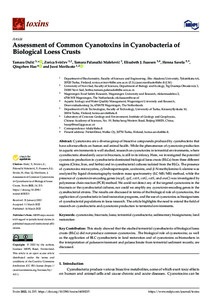Assessment of Common Cyanotoxins in Cyanobacteria of Biological Loess Crusts
Dulić Tamara; Savela Henna; Svirčev Zorica; Hao Qingzhen; Faassen Elisabeth J; Meriluoto Jussi; Malešević Tamara Palanački
Assessment of Common Cyanotoxins in Cyanobacteria of Biological Loess Crusts
Dulić Tamara
Savela Henna
Svirčev Zorica
Hao Qingzhen
Faassen Elisabeth J
Meriluoto Jussi
Malešević Tamara Palanački
MDPI
Julkaisun pysyvä osoite on:
https://urn.fi/URN:NBN:fi-fe2022081153824
https://urn.fi/URN:NBN:fi-fe2022081153824
Tiivistelmä
Cyanotoxins are a diverse group of bioactive compounds produced by cyanobacteria that have adverse effects on human and animal health. While the phenomenon of cyanotoxin production in aquatic environments is well studied, research on cyanotoxins in terrestrial environments, where cyanobacteria abundantly occur in biocrusts, is still in its infancy. Here, we investigated the potential cyanotoxin production in cyanobacteria-dominated biological loess crusts (BLCs) from three different regions (China, Iran, and Serbia) and in cyanobacterial cultures isolated from the BLCs. The presence of cyanotoxins microcystins, cylindrospermopsin, saxitoxins, and beta-N-methylamino-L-alanine was analyzed by liquid chromatography-tandem mass spectrometry (LC-MS/MS) method, while the presence of cyanotoxin-encoding genes (mcyE, cyrJ, sxtA, sxtG, sxtS, and anaC) was investigated by polymerase chain reaction (PCR) method. We could not detect any of the targeted cyanotoxins in the biocrusts or the cyanobacterial cultures, nor could we amplify any cyanotoxin-encoding genes in the cyanobacterial strains. The results are discussed in terms of the biological role of cyanotoxins, the application of cyanobacteria in land restoration programs, and the use of cyanotoxins as biosignatures of cyanobacterial populations in loess research. The article highlights the need to extend the field of research on cyanobacteria and cyanotoxin production to terrestrial environments.
Kokoelmat
- Rinnakkaistallenteet [19207]
